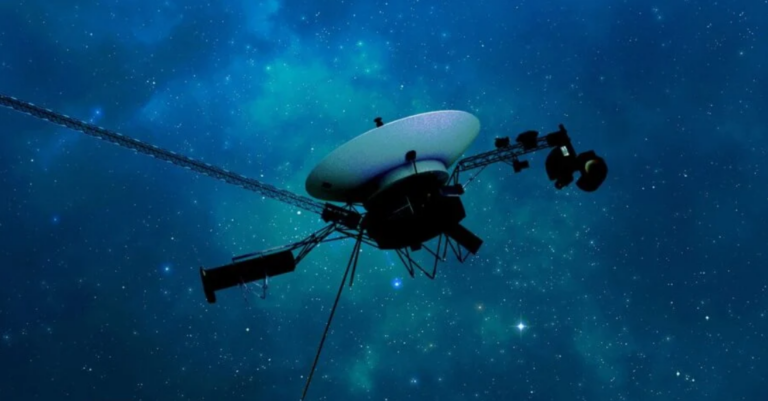NASA successfully repairs Voyager 1 from a distance of 15 billion miles, allowing the probe to resume transmitting data once more
Voyager 1, the beyond-earthmost spacecraft, after significant efforts by engineers through remote troubleshooting, resumed normal communication with NASA as the myriad problems were fixed.
NASA’s Jet Propulsion Laboratory (JPL), the agency’s division responsible for robotic spacecraft creation and operation, had reported in December 2019 that the one hundred and thirty-six-year-old Voyager 1, which is situated halfway between the Earth and the center of the Milky Way galaxy, was sending incomprehensible signals back to Earth.
The JPL team reported that engineers finally began to receive much needed data regarding Voyager 1’s engineering systems status and functionality, which were partly accessible thanks to the team’s creative troubleshooting endeavors. “The next objective is to resume data transmissions from the spacecraft as directed from JPL,” said the mission control center. Meanwhile, irrespective of Voyager 1 failure the probe continued to u jerk Voyager 1
This happened in the year 1977 when Voyager 1 was set to purposefully look at Jupiter and Saturn’s characteristics in the course of five years. Nevertheless, the main goal drifted even from the original plan, as a spacecraft will reach its fifty year of traditional operation in short time.
Spacecraft known as Voyager 1 entered the interstellar space back in August 2012, which makes this craft the first human-made object to ever exceed the borders of the Solar system. Its current speed is around 60 821 km/h, respectively.
Sounding a little more like yourself, #Voyager1.
For the first time since November, Voyager 1 is returning useable data about the health and status of its onboard engineering systems. Next step: Enable the spacecraft to begin returning science data again: https://t.co/eZyqo7uERu pic.twitter.com/6YZM33Mp48— NASA JPL (@NASAJPL) April 22, 2024
The reason were traced back from a malfunction of one of the three onboard computer, who was in charge of processing, transmitting and generating scientific and engineering data for earth. Lacking the ability to reprogram the faulty module, the JPL group decided to move the corrupted system to a better place, which, given the old technology, was harder than you think.
Both the Voyager 1 and its twin Voyager 2 are credited with the budget of approximately 60 kilobytes of memory storage. The memory is comparable to the size of a low image resolution computer file. They are recorded on the analogue digital tapes as their data saving mechanism.
Corrective actions were sent from the Earth with a 2-day delay of receipt of signals on 18 April, and to assess their effectiveness, it took time for radio signals to travel to Voyager 1 and back. “JPL’s confirmation of the successful modification by the spacecraft was also confirmed on 20 April,” JPL representatives were alleged to have said.
In the wake of the announcement, NASA’s Jet Propulsion Laboratory (JPL) shared a picture showing the Voyager flight team members rejoicing in a conference room after being now able to access the necessary information, surrounded by laptops, notepads, and doughnuts.
Canadain retired astronaut Chris Hadfield, who has boarded two space shuttles and has previously held the position of commander of the International Space Station, illustrated the task of JPL as if one would be doing maintenance of old car, using tools on the ground, by comparing it.
“How do you even compare the case when a computer chip crashes in your 1977 vehicle but located in interstellar space, 15 billion miles away, to what happened really to NASA’s Voyager probe?” that was said by nearest the sun astronaut Chris Hadfield about manned space flight X. “He was repaired successfully by that bunch interested engineers at software”.
Voyager’s participating in the imaging of Saturn on many details, that Jupiter has Its rings, and that Volcanoes are active on Jupiter’s moon Io. Moreover, the spacecraft had been able to detect 23 moons around the outer planet
Distance from the sun due to the remote location of the Voyager probes means that they cannot deride from a solar panel for electricity. Instead of burning heat from plutonium radioactive decay to fuel the plant, they formers use electricity to maintain the operations.
NASA plans to keep collecting data from both Voyager spacecraft for several years to come, although the mission becomes harder after 10 years as the signal waves become more difficult to navigate and pick up by radio telescopes on Earth. Voyager 2, taking a bit longer than his lead but still on the track, is also going a bit slower.
The chance of such a possibility happening in 40 thousands of years is almost zero due to the expected passage of the probe not too far from two stars. Voyager 1 is expected to come almost 2 light years from a star in the Ursa Minor constellation, where Voyager 2 is also predicted to reach the Andromeda constellation’s star, Ross 248, at a distance of almost 2 light years too.
Do not forget to share your opinion with us to provide you with the best posts !





0 Comments